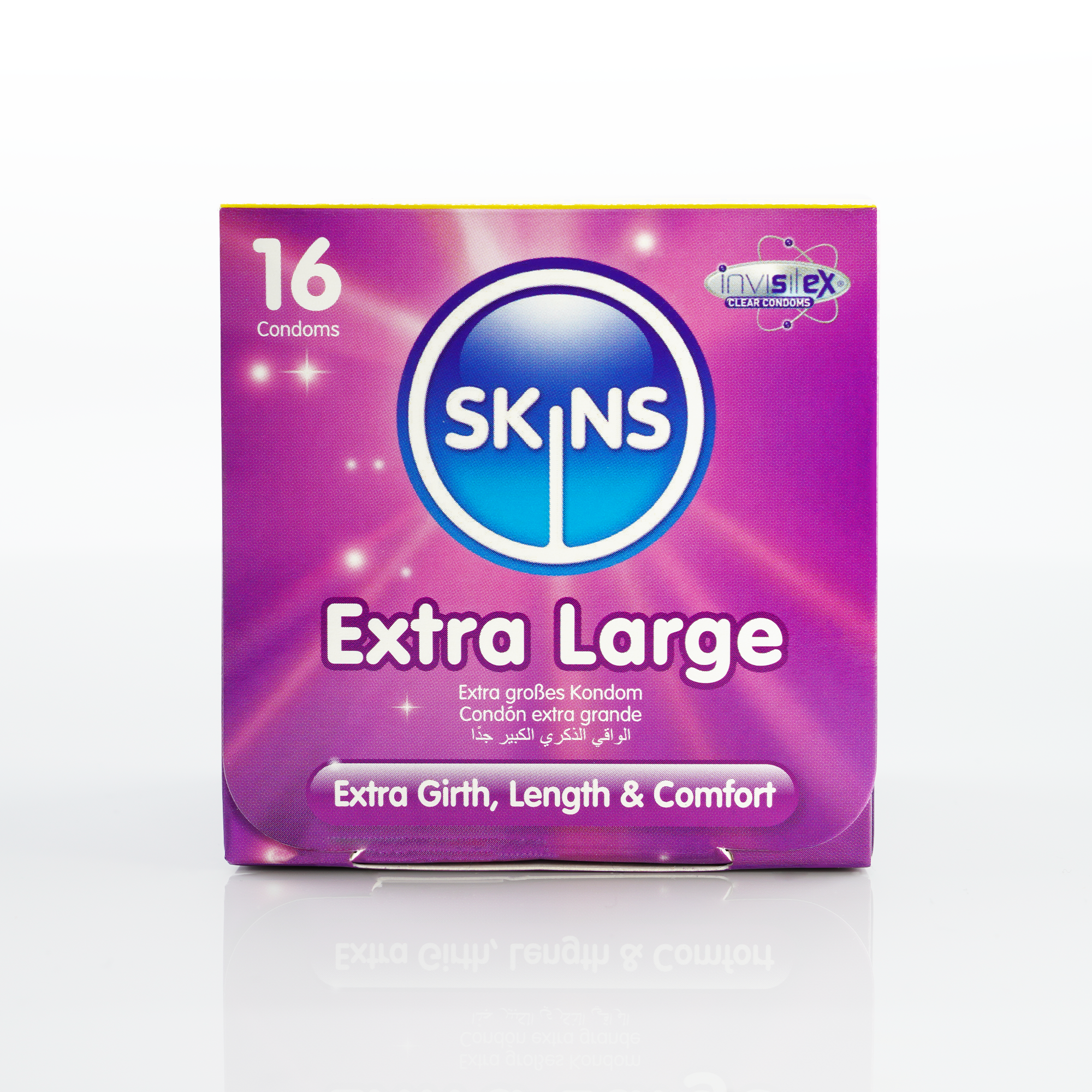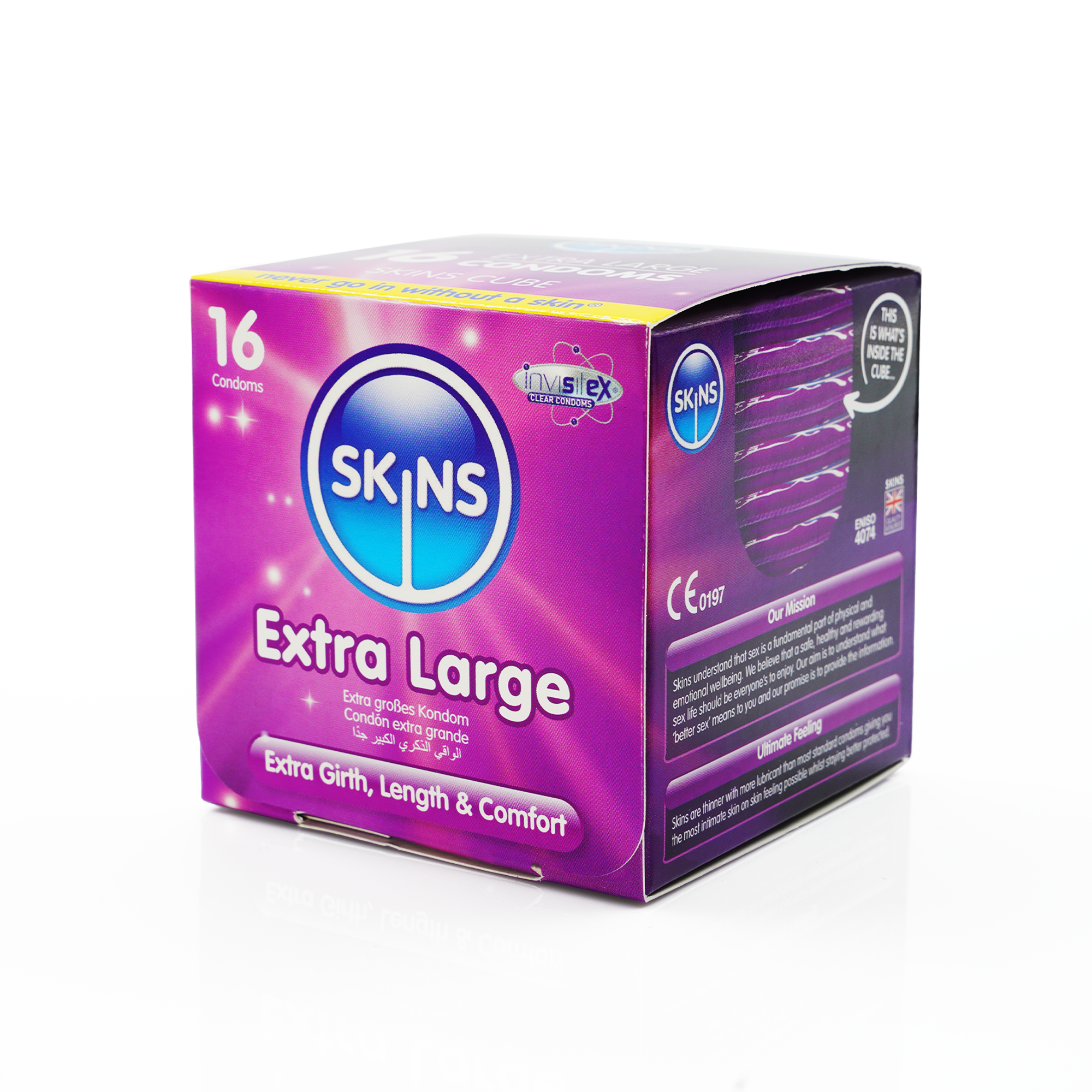Other Options Include
What is Skins Extra Large Condom?
Skins Extra Large Condoms are a product offered by the Skins brand. As the name suggests, these condoms are designed for individuals who require a larger size to ensure a comfortable and secure fit during sexual activity.
Key features of Skins Extra Large Condoms include:
1. Larger Dimensions: These condoms are typically longer and wider than regular-sized condoms. This makes them more suitable for individuals who find standard-sized condoms to be too tight or restrictive.
2. Lubrication: These condoms come with a lubricant to enhance comfort and reduce friction during use.
It's essential to choose the right condom size to ensure both safety and comfort during sexual activity. Using a condom that's too tight can increase the risk of breakage, while using one that's too loose may not provide adequate protection. If you or your partner require an extra-large size condom, it's advisable to select a product like Skins Extra Large Condoms to ensure a proper fit.
How to put a Condom on?
Putting on a condom correctly is important to ensure it provides the protection it's designed for. Here are step-by-step instructions on how to put on a condom:
1. Open the Packaging: Carefully open the condom packet by tearing it along the edge, but be cautious not to damage the condom inside.
2. Determine the Right Side: Condoms have two sides: one that is rolled up and one that is unrolled. It should be pretty easy to figure out the correct side to unroll, but make sure you're unrolling it in the right direction.
3. Pinch the Tip: Squeeze the tip of the condom to remove any air and create a small reservoir for semen. This step is essential to prevent the condom from bursting.
4. Roll It On: With one hand, hold the tip of the condom you pinched in step 4. Use your other hand to unroll the condom down the shaft of the erect penis. If you're not circumcised, you may need to pull back the foreskin before putting on the condom.
5. Smooth It Out: After you've unrolled the condom all the way down the penis, smooth out any air bubbles or wrinkles. A condom should fit snugly, but not be too tight or too loose.
6. Use Lubrication (if needed): If the condom is not pre-lubricated, or if you want additional lubrication, you can apply a water-based or silicone-based lubricant to the outside of the condom. Do not use oil-based lubricants, as they can weaken the condom.
7. During and After Sex: Ensure the condom stays in place during sexual activity. After ejaculation, hold the base of the condom while withdrawing to prevent any spillage. Carefully remove the condom and dispose of it properly. Do not flush it down the toilet.
A few important points to remember:
- Use a new condom for each sexual encounter.
- Condoms should be put on before any genital contact or penetration.
- Do not reuse condoms.
- Never use two condoms at the same time, as they can friction against each other and break.
- If you experience any discomfort, allergic reactions, or the condom breaks, stop immediately and replace the condom.
Properly using a condom is a crucial part of safe sex to protect against sexually transmitted infections (STIs) and unintended pregnancies. If you're unsure or have difficulty using condoms, it's a good idea to practice on your own before a sexual encounter to ensure you're comfortable with the process.
Side Effects Of Condoms
Condoms are generally considered a safe and effective method of contraception and protection against sexually transmitted infections (STIs). However, like any product, they may have some side effects or issues that can arise, although they are typically minimal and not serious. Some of the potential side effects and issues associated with condom use include:
1. Allergic Reactions: Some individuals may be allergic to latex, which is the material used in most condoms. If you or your partner experiences itching, redness, or rash after using latex condoms, it may be an allergic reaction. In this case, you can switch to non-latex alternatives, such as polyurethane or polyisoprene condoms.
2. Breakage: Condoms can break if they are used incorrectly or if they are damaged. Common causes of breakage include not leaving enough space at the tip, using oil-based lubricants (which can weaken latex), or not unrolling the condom all the way.
3. Slippage: Condoms can sometimes slip off during intercourse if they are too large, not put on correctly, or if they are not snugly fitted. Ensuring the correct condom size and proper application can help reduce this risk.
4. Reduced Sensation: Some individuals may find that using a condom reduces sensation during sexual intercourse. This can be both a side effect and a benefit, depending on your perspective. Some people prefer the added security that condoms provide, while others may feel that it reduces sensitivity.
5. Latex Smell and Taste: Latex condoms can have a distinct odor and taste, which some people find unpleasant. Using flavored condoms or non-latex alternatives can help mitigate this issue.
6. Irritation: In rare cases, individuals may experience irritation or discomfort due to friction or sensitivity to the lubricant used on the condom. Using a condom with a different type of lubricant or using your own water-based lubricant can help.
7. Emotional Factors: Some people may experience emotional or psychological side effects related to condom use, such as concerns about reduced intimacy or trust issues. Open communication with your partner and finding solutions that work for both of you can help address these concerns.
It's important to note that the benefits of using condoms in terms of preventing STIs and unintended pregnancies often far outweigh these potential side effects. If you experience persistent or severe side effects, consider talking to a healthcare provider or a sexual health expert for guidance and alternative options. Remember that proper use of condoms is essential to maximize their effectiveness and minimize any potential side effects.





